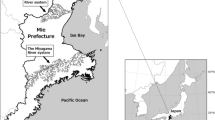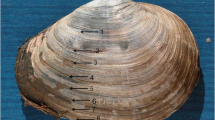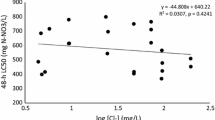Abstract
Catecholamines play essential roles in several physiological processes in vertebrates as well as in invertebrates. While several studies have shown the presence of these substances in surface water invertebrates, their occurrence in groundwater fauna is unproven. In the present study, the presence of different catecholamines (i.e., noradrenaline, adrenaline, and dopamine) in individual specimens of groundwater amphipods of the genus Niphargus (mostly Niphargus inopinatus) was investigated via two independent analytical methods: HPLC/EcD and UPLC/TOF-MS. Mean values for catecholamine levels were 533 pg mg−1 fresh weight for noradrenaline, 314 pg mg−1 for adrenaline, and 16.4 ng mg−1 for dopamine. The optimized protocol allowed the detection of CAs in single organisms of less than 1 mg fresh weight. Catecholamine concentration patterns in groundwater invertebrates are briefly discussed here with respect to their evolutionary adaptation to an environmentally stable, energy-poor habitat.

Niphargus inopinatus SCHELLENBERG (photo: Günter Teichmann,Helmholtz Center Munich)






Similar content being viewed by others
References
Ottaviani E, Franceschi C (1996) The neuroimmunology of stress from invertebrates to man. Prog Neurobiol 48:421–440
Chen M et al (2008) Catecholaminergic responses to environmental stress in the hemolymph of Zhikong scallop Chlamys farreri. J Exp Zool A Ecol Genet Physiol 309A(6):289–296
Lacoste A et al (2001) Evidence for a form of adrenergic response to stress in the mollusc Crassostrea gigas. J Exp Biol 204:1247–1255
Lacoste A et al (2001) Stress-induced catecholamine changes in the hemolymph of the oyster Crassostrea gigas. Gen Comp Endocrinol 122(2):181–188
Lacoste A et al (2001) Noradrenaline modulates hemocyte reactive oxygen species production via β-adrenergic receptors in the oyster Crassostrea gigas. Dev Comp Immunol 25(4):285–289
Lacoste A et al (2002) Stress-induced immune changes in the oyster Crassostrea gigas. Dev Comp Immunol 26(1):1–9
Wendelaar Bonga SE (1997) The stress response in fish. Physiol Rev 77(3):591–625
Teyke T et al (1993) Dopaminergic neuron B20 generates rhythmic neuronal activity in the feeding motor circuitry of Aplysia. Brain Res 630(1–2):226–237
Sakharov DA, Salànski J (1982) Effects of dopamine antagonists on snail locomotion. Experientia 38:1090–1091
McDonald PW et al (2007) Vigorous motor activity in Caenorhabditis elegans requires efficient clearance of dopamine mediated by synaptic localization of the dopamine transporter DAT-1. J Neurosci 27(51):14216–14227
McDonald PW et al (2006) Dopamine signaling architecture in Caenorhabditis elegans. Cell Mol Neurobiol 26(4–6):593–618
Aparicio-Simón B et al (2010) Neuroendocrine and metabolic responses of Pacific whiteleg shrimp Litopenaeus vannamei exposed to acute handling stress. Aquaculture 298(3–4):308–314
Gibert J et al (1994) Basic attributes of groundwater ecosystems and prospects for research. In: Gibert J, Danielopol DL, Stanford JA (eds) Groundwater ecology. Academic, San Diego, pp 7–40
Malard F et al (1994) The use of invertebrate communities to describe groundwater flow and contaminant transport in a fractured rock aquifer. Arch Hydrobiol 131:93–110
Sket B (1999) The nature of biodiversity in hypogean waters and how it is endangered. Biodivers Conserv 8(10):1319–1338
Novak D (1993) Hydrogeological research of the Slovenian karst. Naše Jame [Our Caves] 36(1):15–20
Brielmann H et al (2009) Effects of thermal energy discharge on shallow groundwater ecosystems. FEMS Microbiol Ecol 68(3):273–286
Hahn HJ, Fuchs A (2009) Distribution patterns of groundwater communities across aquifer types in southwestern Germany. Freshw Biol 54:848–860
Griebler C et al (2010) Ecological assessment of groundwater ecosystems—vision or illusion? Ecol Eng 36(9):1174–1190
Stein H et al (2010) The potential use of fauna and bacteria as ecological indicators for the assessment of groundwater quality. J Environ Monit 12(1):242–254
Väinölä R et al (2008) Global diversity of amphipods (Amphipoda; Crustacea) in freshwater. Hydrobiologia 595(1):241–255
Holsinger J (1994) Pattern and process in the biogeography of subterranean amphipods. Hydrobiologia 287(1):131–145
Karaman GS, Rufflo S (1986) Amphipoda: Niphargus-group (Niphargidae sensu Bousfield). In: Botosaneunu L (eds) Stygofauna mundi. E.J. Brill/Backhys, Leiden
Cooke IM, Goldstone MW (1970) Fluorescence localization of monoamines in crab neurosecretory structures. J Exp Biol 53(3):651–668
Kushner PD, Maynard EA (1977) Localization of monoamine fluorescence in the stomatogastric nervous system of lobsters. Brain Res 129(1):13–28
El Bakary Z, Fuzeau-Braesch S, Papin C (1988) Detection of biogenic amines and nychthemeral variations in the scorpion Leiurus quinquestriatus. Comp Biochem Physiol C Comp Pharmacol 90(1):173–177
Schimizu T, Nihara M, Takeda N (1991) High performance liquid chromatography of biogenic amines in the corpus cardicum of the American cockroach Periplaneta americana. J Chromatogr 539:193–197
Moesslacher F, des Chatelliers MC (1996) Physiological and behavioural adaptations of an epigean and a hypogean dwelling population of Asellus aquaticus (L) (Crustacea, Isopoda). Arch Hydrobiol 138(2):187–198
Moesslacher F (2000) Sensitivity of groundwater and surface water crustaceans to chemical pollutants and hypoxia: implications for pollution management. Arch Hydrobiol 149(1):51–66
Simčič T, Brancelj A (2007) The effect of light on oxygen consumption in two amphipod crustaceans—the hypogean Niphargus stygius and the epigean Gammarus fossarum. Mar Freshw Behav Physiol 40(2):141–150
Fišer C, Sket B, Trontelj P (2010) Niphargus homepage. http://niphargus.info/. Cited 7 May 2010
Bauer M, Fulda B, Blodau C (2008) Groundwater derived arsenic in high carbonate wetland soils: sources, sinks, and mobility. Sci Total Environ 401(1–3):109–120
Bauer M et al (2006) The geology of Munich (Germany) and its significance for ground modelling in urban areas (paper no. 454). In: Culshaw M et al (eds) IAEG2006—engineering geology for tomorrow’s cities. Proceedings of the 10th IAEG International Congress, Nottingham, United Kingdom, 6–10 Sept. 2006. Geological Society of London, London, pp 1–7
RECIPE Chemicals + Instruments GmbH (2013) RECIPE®: instructions for determination of catecholamines in plasma by HPLC, version 3.4, 11/2009, code KAT-P_D_MAN.doc. http://www.recipe.de
Chan EC, Ho PC (2000) High-performance liquid chromatography/atmospheric pressure chemical ionization mass spectrometric method for the analysis of catecholamines and metanephrines in human urine. Rapid Commun Mass Spectrom 14(21):1959–1964
Macdonald R (2006) Quality assessment of quantitative analytical results in laboratory medicine by root mean square of measurement deviation/Bewertung der Qualität quantitativer analytischer Ergebnisse in der Laboratoriumsmedizin anhand des quadratischen Mittelwertes der Messabweichung. LaboratoriumsMedizin 30:111–117
Poulson TL, White WB (1969) The cave environment. Science 165(3897):971–981
Culver DC (1982) Cave life. Evolution and ecology. Harvard University Press, Cambridge
Hervant F, Mathieu J, Barre H (1999) Comparative study on the metabolic responses of subterranean and surface-dwelling amphipods to long-term starvation and subsequent refeeding. J Exp Biol 202:3587–3595
Merali S, Clarkson AB Jr (1996) Polyamine analysis using N-hydroxysuccinimidyl-6-aminoquinoyl carbamate for pre-column derivatization. J Chromatogr B 675(2):321–326
Coppi A, Merali S, Eichinger D (2002) The enteric parasite Entamoeba uses an autocrine catecholamine system during differentiation into the infectious cyst stage. J Biol Chem 277(10):8083–8090
Liu G, Chen J, Ma Y (2004) Simultaneous determination of catecholamines and polyamines in PC-12 cell extracts by micellar electrokinetic capillary chromatography with ultraviolet absorbance detection. J Chromatogr B 805(2):281–288
Acknowledgements
Maria Avramov and Christian Griebler were involved in conceptual project development, performed the sampling, and determined the amphipod species present. Moreover, both authors substantially contributed to data interpretation as well as the writing and editing of the manuscript. M.A. received financial support in terms of a scholarship by the German Federal Environmental Foundation (DBU, grant 20009/005, 2009–2012).
Author information
Authors and Affiliations
Corresponding author
Electronic supplementary material
Below is the link to the electronic supplementary material.
ESM 1
(PDF 138 KB kb)
Rights and permissions
About this article
Cite this article
Pfister, G., Rieb, J., Avramov, M. et al. Detection of catecholamines in single specimens of groundwater amphipods. Anal Bioanal Chem 405, 5571–5582 (2013). https://doi.org/10.1007/s00216-013-6952-8
Received:
Revised:
Accepted:
Published:
Issue Date:
DOI: https://doi.org/10.1007/s00216-013-6952-8




